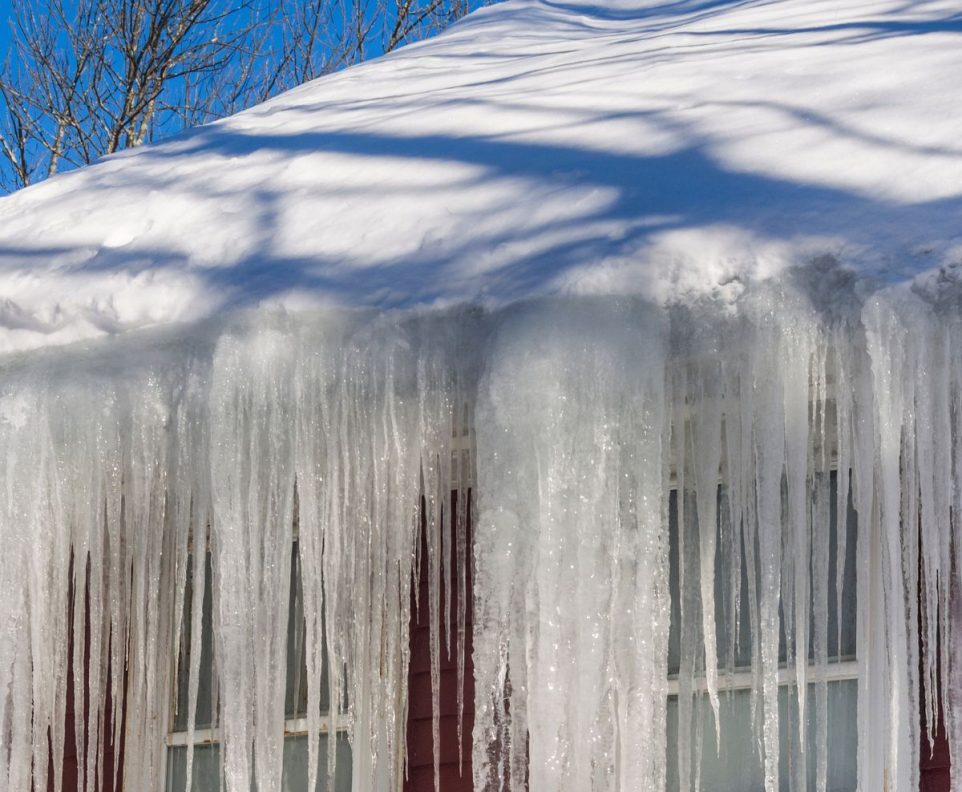Fast, Free Estimates on Roof Replacement, Installation or Repair | Call today! (732)740-6561
Avoiding Ice Dams in NJ: Roof & Attic Steps You Should Take Now
When temperatures in New Jersey start to drop, homeowners often turn their attention to insulation, heating systems, and drafty windows. But one of the most damaging winter problems often begins where you can’t easily see it: at the edge of your roof.
Ice dams are a familiar threat in our climate, and they can lead to leaks, damaged insulation, and costly roof repairs if ignored. The good news is that ice dams are entirely preventable with the right combination of roof care, attic maintenance, and timely inspections.
What Are Ice Dams and Why Do They Form?
Ice dams occur when snow on your roof melts, then refreezes near the colder edges or gutters. This cycle of melting and refreezing creates thick ridges of ice that trap water behind them. Since water always seeks a way down, it can back up under your shingles and leak into your home.
The root cause of this process is usually uneven roof temperature. Warm air from the living space below escapes into the attic, heating the underside of the roof and melting snow unevenly. As melted water reaches the colder eaves, it freezes again, forming a dam. Over time, the weight and trapped moisture can cause water intrusion, ceiling stains, insulation damage, and even mold growth.

Step 1: Start with a Professional Roof Inspection

Before winter weather sets in, schedule a roof inspection with a qualified New Jersey roofing contractor. A professional can identify issues like worn flashing, missing shingles, or poor ventilation, all of which can contribute to ice dam formation. They can also check the roof pitch, overhang, and gutter setup to ensure snow and ice can shed properly.
If you’ve noticed icicles forming on your gutters in past winters, that’s a warning sign. An inspection in November gives you time to correct problems before heavy snow arrives. Catching these issues now can save you from major water damage later in the season.
Step 2: Improve Attic Insulation and Air Sealing

Proper insulation is the single most effective way to prevent ice dams. Inadequate or uneven insulation allows warm air to escape through the ceiling and heat parts of the roof deck. That heat melts snow faster in some spots than others, setting the stage for ice buildup.
Have an insulation professional check your attic’s R-value, which measures thermal resistance. In most New Jersey homes, the recommended attic insulation is at least R-38 to R-49, depending on the home’s age and structure.
The technician should also look for air leaks around plumbing vents, recessed lighting, and attic hatches. Sealing those gaps with caulk or foam prevents warm air from escaping into the attic.
Step 3: Ensure Proper Ventilation in the Attic

Good attic ventilation keeps the indoor temperature closer to the outdoor temperature, which minimizes snowmelt on the roof. This balance is achieved with a combination of soffit vents (which draw in cool air) and ridge vents (which release warm air). When these are working together, your roof stays cool, and snow melts more evenly.
Ask your roofing professional to check for blocked or undersized vents. Over time, insulation can shift or debris can collect, preventing air from flowing freely. In some homes, adding a ridge vent or powered exhaust fan can significantly improve airflow and reduce heat buildup.
Step 4: Keep Gutters and Downspouts Clear

Clogged gutters make ice dams worse. When leaves, twigs, or shingle granules block water flow, melted snow has nowhere to go. It pools, freezes, and forms heavy ice ridges that strain gutters and soffits.
Before the first snow, make sure your gutters are clean and securely attached. Consider installing gutter guards if debris is a recurring issue. In addition, check that downspouts extend several feet away from your foundation to direct melting snow safely away from the home.
Step 5: Safely Remove Snow When Needed

Even with great insulation and ventilation, heavy snow can still create risk. Using a roof rake after a major storm can help clear snow from the eaves before it freezes. Work from the ground with a telescoping rake rather than climbing onto the roof, which can be dangerous and damage shingles.
If a thick ice dam has already formed, avoid trying to chip or melt it yourself. The safest move is to call a professional roofing or ice removal service that uses steam systems or approved de-icing methods.
Step 6: Plan for Long-Term Roof Protection

If your home experiences ice dams year after year, it may be time to explore more permanent solutions. A roofing contractor can install heat cables along eaves or upgrade underlayment to an ice and water shield, which acts as a waterproof barrier under shingles. Some homeowners choose to replace older ventilation systems or add continuous ridge vents to maintain consistent airflow.
When combined with proper attic insulation and professional maintenance, these upgrades make your home more energy-efficient and more resilient against winter damage.
Protecting Your Roof Means Protecting Your Home
Ice dams are not just a nuisance. They’re a warning sign that your roof system is out of balance. Addressing the causes now, before freezing weather sets in, will protect your roof, prevent costly repairs, and improve your home’s comfort.
If you’re unsure where to begin, reach out to a trusted New Jersey roofing professional for an attic and roof inspection. A little preparation in November can spare you from leaks, repairs, and frustration all winter long.
If you are in Monmouth, Ocean, or Middlesex Counties and are concerned about your roof being at risk for ice dams, contact our team at 4 Seasons Roofing Company today for a free inspection. We will thoroughly inspect potential problem areas, identify any issues, and recommend a repair or replacement that will help prevent ice dams in the future.
